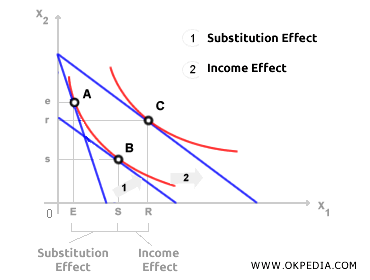Price Effect
In microeconomics, the price effect refers to how a change in the price of a good influences the quantity demanded. This effect is driven by two distinct forces: the substitution effect and the income effect.
- Substitution Effect. The substitution effect describes the shift in quantity demanded of goods as a response to a change in their relative prices. For example, if the price of good X1 rises, the price ratio between X1 and good X2 changes, leading to decreased demand for X1 in favor of X2. The substitution effect is consistently negative.
- Income Effect. The income effect captures the change in quantity demanded due to the impact on consumer purchasing power resulting from a price change. For instance, when the price of good X1 increases, it not only affects relative prices but also indirectly reduces the consumer’s real income, limiting the amount they can buy at the same nominal income. The income effect can be either negative or positive, depending on the context.

For a more in-depth look at the substitution effect and the income effect, please refer to the individual pages. These two aspects of the price effect can be analyzed and visually represented using two main approaches:
- Hicks Method. The Hicks method models and quantifies income and substitution effects by identifying a theoretical third consumption bundle with the same level of utility (welfare).
- Slutsky Method. The Slutsky method models and quantifies income and substitution effects by finding a theoretical comparison bundle that maintains the same level of real income (purchasing power).
https://www.okpedia.com/price-effect
Have a question? Leave it in the comments and we'll answer on this page.
